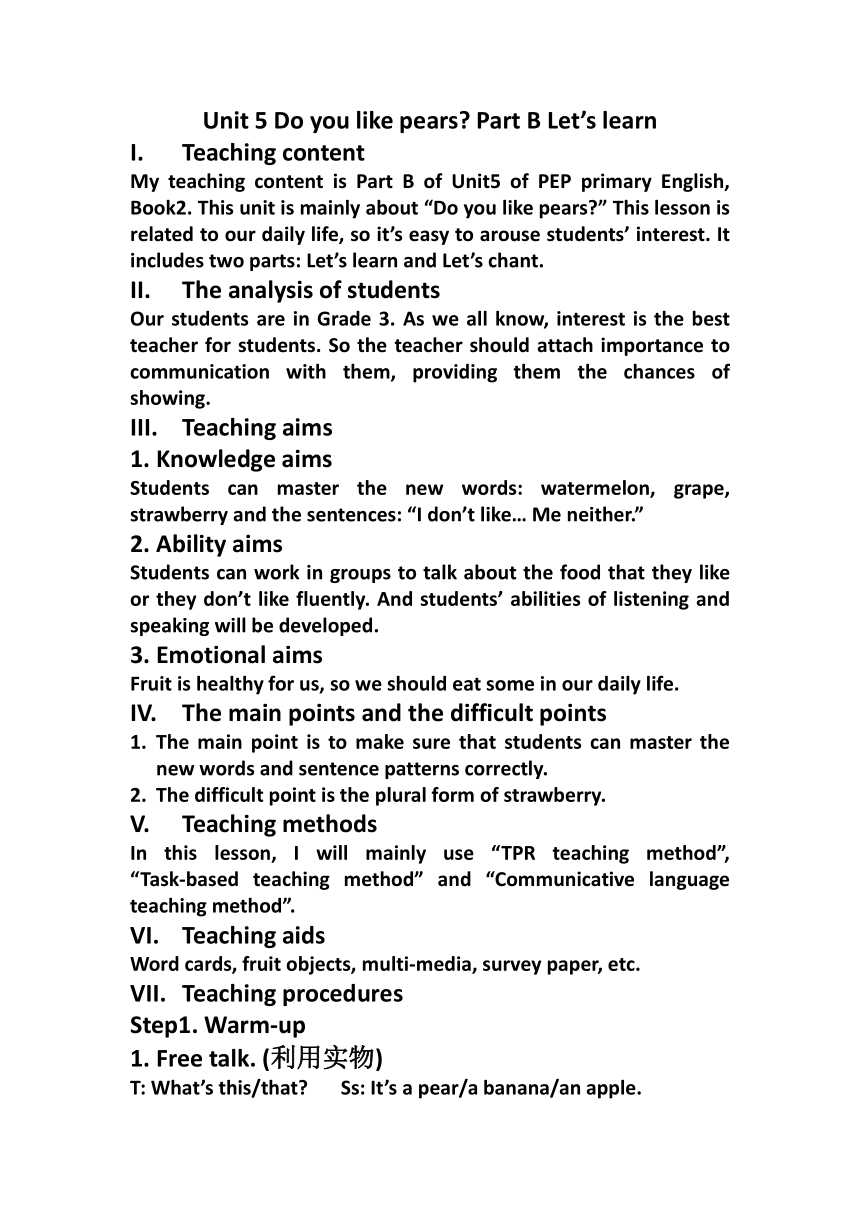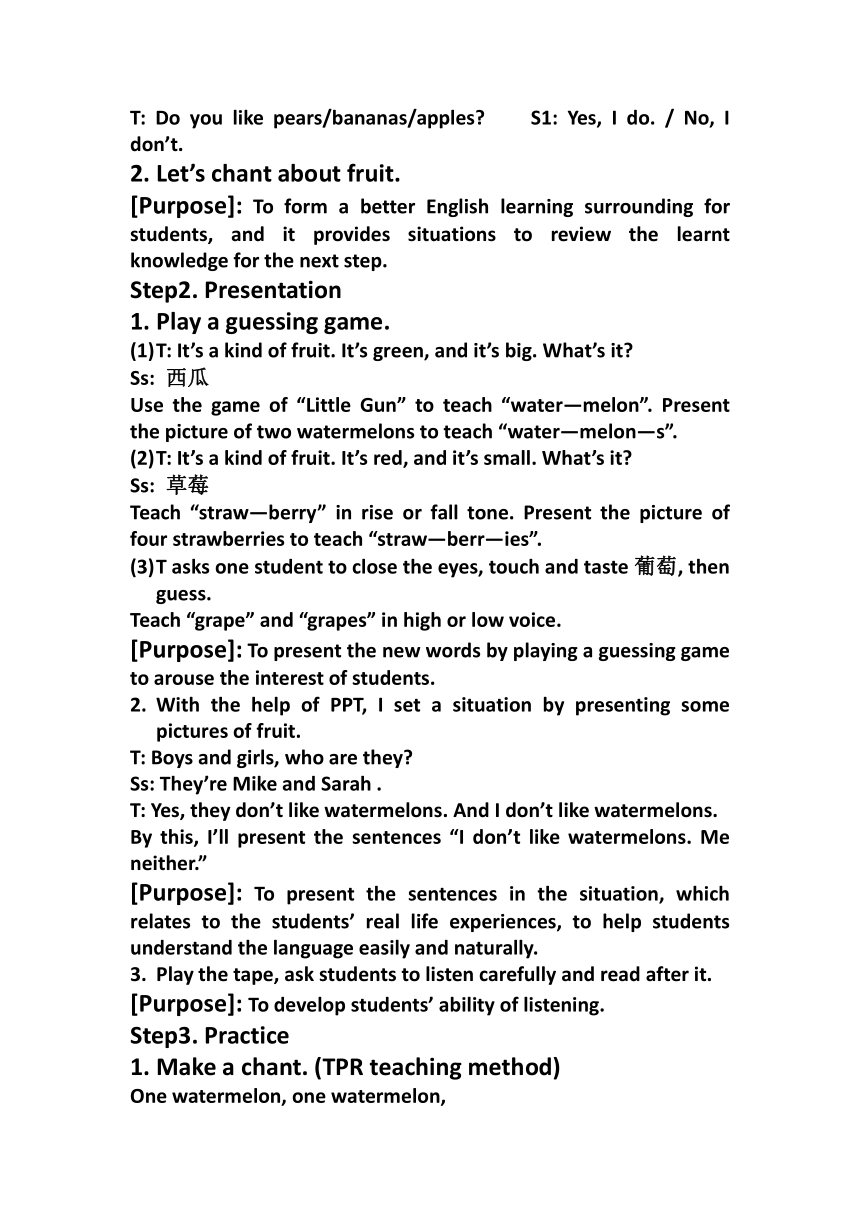Unit 5 Do you like pears? Part B Let’s learn 教案
文档属性
| 名称 | Unit 5 Do you like pears? Part B Let’s learn 教案 |  | |
| 格式 | zip | ||
| 文件大小 | 18.8KB | ||
| 资源类型 | 教案 | ||
| 版本资源 | 人教版(PEP) | ||
| 科目 | 英语 | ||
| 更新时间 | 2022-02-06 21:31:07 | ||
图片预览


文档简介
Unit 5 Do you like pears Part B Let’s learn
Teaching content
My teaching content is Part B of Unit5 of PEP primary English, Book2. This unit is mainly about “Do you like pears ” This lesson is related to our daily life, so it’s easy to arouse students’ interest. It includes two parts: Let’s learn and Let’s chant.
The analysis of students
Our students are in Grade 3. As we all know, interest is the best teacher for students. So the teacher should attach importance to communication with them, providing them the chances of showing.
Teaching aims
Knowledge aims
Students can master the new words: watermelon, grape, strawberry and the sentences: “I don’t like… Me neither.”
Ability aims
Students can work in groups to talk about the food that they like or they don’t like fluently. And students’ abilities of listening and speaking will be developed.
Emotional aims
Fruit is healthy for us, so we should eat some in our daily life.
The main points and the difficult points
The main point is to make sure that students can master the new words and sentence patterns correctly.
The difficult point is the plural form of strawberry.
Teaching methods
In this lesson, I will mainly use “TPR teaching method”, “Task-based teaching method” and “Communicative language teaching method”.
Teaching aids
Word cards, fruit objects, multi-media, survey paper, etc.
Teaching procedures
Step1. Warm-up
Free talk. (利用实物)
T: What’s this/that Ss: It’s a pear/a banana/an apple.
T: Do you like pears/bananas/apples S1: Yes, I do. / No, I don’t.
Let’s chant about fruit.
[Purpose]: To form a better English learning surrounding for students, and it provides situations to review the learnt knowledge for the next step.
Step2. Presentation
Play a guessing game.
T: It’s a kind of fruit. It’s green, and it’s big. What’s it
Ss: 西瓜
Use the game of “Little Gun” to teach “water—melon”. Present the picture of two watermelons to teach “water—melon—s”.
T: It’s a kind of fruit. It’s red, and it’s small. What’s it
Ss: 草莓
Teach “straw—berry” in rise or fall tone. Present the picture of four strawberries to teach “straw—berr—ies”.
T asks one student to close the eyes, touch and taste葡萄, then guess.
Teach “grape” and “grapes” in high or low voice.
[Purpose]: To present the new words by playing a guessing game to arouse the interest of students.
With the help of PPT, I set a situation by presenting some pictures of fruit.
T: Boys and girls, who are they
Ss: They’re Mike and Sarah .
T: Yes, they don’t like watermelons. And I don’t like watermelons.
By this, I’ll present the sentences “I don’t like watermelons. Me neither.”
[Purpose]: To present the sentences in the situation, which relates to the students’ real life experiences, to help students understand the language easily and naturally.
Play the tape, ask students to listen carefully and read after it.
[Purpose]: To develop students’ ability of listening.
Step3. Practice
Make a chant. (TPR teaching method)
One watermelon, one watermelon,
Two watermelons, two watermelons,
I don’t like watermelons. I don’t like watermelons.
Me neither. Me neither.
One strawberry, four strawberries,
I don’t like strawberries. Me neither.
[Purpose]: To help students remember the new words and sentences.
Role-play
Divide Ss into 2 groups (Watermelon group &Strawberry group) to have a competition.
Give students 2 minutes to work in pairs to play a new dialogue, then ask some pairs to act it out in class.
[Purpose]: Making a new dialogue is to check if students can use the sentences “I don’t like… Me neither.” correctly. And to develop students’ abilities of communication and cooperation.
Step4. Consolidation
Do a survey.
Ask Ss to take out the survey paper and give them 3minutes to prepare.
S1: Hi! I’m … I like… But I don’t like…
S2: …
[Purpose]:To develop students’ ability of self-study.
Step5. Homework
Do a survey about their good friends or family members.
[Purpose]: To improve students’ abilities of speaking and communication.
Layout design
[Purpose]: To make the language points clear and keep students’ interest of learning English.
教学反思:
这节课的课堂教学活动设计结构清晰,层次分明,整堂课我特别注意关注学生的兴趣和情感的调动,达到了较理想的教学效果。
在Warm-up 环节Free talk和一首Chant的导入复习了前一课时的单词和句型。之后通过猜谜游戏呈现新的教学内容,在这一节课我充分运用直观教学法。新授单词的教读,都是利用图片与实物,发挥了直观的优势。接着利用Zoom这一卡通人物让学生在语境中学习新句型,在潜移默化中掌握语言,教学效果不错。在Practice环节我首先设计了一个chant来帮助学生记住单词和句型。接着我通过Pair work联系生活实际,设计让学生互相交流各自不喜欢的水果,既真实又有趣,激发了学生的学习兴趣。在巩固环节我设计了一个调查表的任务型教学,让学生由被动的知识容器变成积极的探索者,使学生体会到成功带来的喜悦,学习兴趣更浓了。
但也有不足之处,在教学活动中肢体语言不够丰富,三年级学生观察事物还是很简单,需要老师用一些夸张的动作或语气来调动他们的积极性。此外对学生的评价过于单调,比如,我让学生说说时,大部分学生都积极开动了脑筋,有的说的非常的好,我为了不浪费时间,只是以good, great带过,显然学生对这样的评价不够满意。如果我能针对一些突出的回答,加以更好的评价的话,学生应该还可以更活跃。总之在以后的教学过程中,我应不断改进取得更好的教学效果。
Teaching content
My teaching content is Part B of Unit5 of PEP primary English, Book2. This unit is mainly about “Do you like pears ” This lesson is related to our daily life, so it’s easy to arouse students’ interest. It includes two parts: Let’s learn and Let’s chant.
The analysis of students
Our students are in Grade 3. As we all know, interest is the best teacher for students. So the teacher should attach importance to communication with them, providing them the chances of showing.
Teaching aims
Knowledge aims
Students can master the new words: watermelon, grape, strawberry and the sentences: “I don’t like… Me neither.”
Ability aims
Students can work in groups to talk about the food that they like or they don’t like fluently. And students’ abilities of listening and speaking will be developed.
Emotional aims
Fruit is healthy for us, so we should eat some in our daily life.
The main points and the difficult points
The main point is to make sure that students can master the new words and sentence patterns correctly.
The difficult point is the plural form of strawberry.
Teaching methods
In this lesson, I will mainly use “TPR teaching method”, “Task-based teaching method” and “Communicative language teaching method”.
Teaching aids
Word cards, fruit objects, multi-media, survey paper, etc.
Teaching procedures
Step1. Warm-up
Free talk. (利用实物)
T: What’s this/that Ss: It’s a pear/a banana/an apple.
T: Do you like pears/bananas/apples S1: Yes, I do. / No, I don’t.
Let’s chant about fruit.
[Purpose]: To form a better English learning surrounding for students, and it provides situations to review the learnt knowledge for the next step.
Step2. Presentation
Play a guessing game.
T: It’s a kind of fruit. It’s green, and it’s big. What’s it
Ss: 西瓜
Use the game of “Little Gun” to teach “water—melon”. Present the picture of two watermelons to teach “water—melon—s”.
T: It’s a kind of fruit. It’s red, and it’s small. What’s it
Ss: 草莓
Teach “straw—berry” in rise or fall tone. Present the picture of four strawberries to teach “straw—berr—ies”.
T asks one student to close the eyes, touch and taste葡萄, then guess.
Teach “grape” and “grapes” in high or low voice.
[Purpose]: To present the new words by playing a guessing game to arouse the interest of students.
With the help of PPT, I set a situation by presenting some pictures of fruit.
T: Boys and girls, who are they
Ss: They’re Mike and Sarah .
T: Yes, they don’t like watermelons. And I don’t like watermelons.
By this, I’ll present the sentences “I don’t like watermelons. Me neither.”
[Purpose]: To present the sentences in the situation, which relates to the students’ real life experiences, to help students understand the language easily and naturally.
Play the tape, ask students to listen carefully and read after it.
[Purpose]: To develop students’ ability of listening.
Step3. Practice
Make a chant. (TPR teaching method)
One watermelon, one watermelon,
Two watermelons, two watermelons,
I don’t like watermelons. I don’t like watermelons.
Me neither. Me neither.
One strawberry, four strawberries,
I don’t like strawberries. Me neither.
[Purpose]: To help students remember the new words and sentences.
Role-play
Divide Ss into 2 groups (Watermelon group &Strawberry group) to have a competition.
Give students 2 minutes to work in pairs to play a new dialogue, then ask some pairs to act it out in class.
[Purpose]: Making a new dialogue is to check if students can use the sentences “I don’t like… Me neither.” correctly. And to develop students’ abilities of communication and cooperation.
Step4. Consolidation
Do a survey.
Ask Ss to take out the survey paper and give them 3minutes to prepare.
S1: Hi! I’m … I like… But I don’t like…
S2: …
[Purpose]:To develop students’ ability of self-study.
Step5. Homework
Do a survey about their good friends or family members.
[Purpose]: To improve students’ abilities of speaking and communication.
Layout design
[Purpose]: To make the language points clear and keep students’ interest of learning English.
教学反思:
这节课的课堂教学活动设计结构清晰,层次分明,整堂课我特别注意关注学生的兴趣和情感的调动,达到了较理想的教学效果。
在Warm-up 环节Free talk和一首Chant的导入复习了前一课时的单词和句型。之后通过猜谜游戏呈现新的教学内容,在这一节课我充分运用直观教学法。新授单词的教读,都是利用图片与实物,发挥了直观的优势。接着利用Zoom这一卡通人物让学生在语境中学习新句型,在潜移默化中掌握语言,教学效果不错。在Practice环节我首先设计了一个chant来帮助学生记住单词和句型。接着我通过Pair work联系生活实际,设计让学生互相交流各自不喜欢的水果,既真实又有趣,激发了学生的学习兴趣。在巩固环节我设计了一个调查表的任务型教学,让学生由被动的知识容器变成积极的探索者,使学生体会到成功带来的喜悦,学习兴趣更浓了。
但也有不足之处,在教学活动中肢体语言不够丰富,三年级学生观察事物还是很简单,需要老师用一些夸张的动作或语气来调动他们的积极性。此外对学生的评价过于单调,比如,我让学生说说时,大部分学生都积极开动了脑筋,有的说的非常的好,我为了不浪费时间,只是以good, great带过,显然学生对这样的评价不够满意。如果我能针对一些突出的回答,加以更好的评价的话,学生应该还可以更活跃。总之在以后的教学过程中,我应不断改进取得更好的教学效果。
